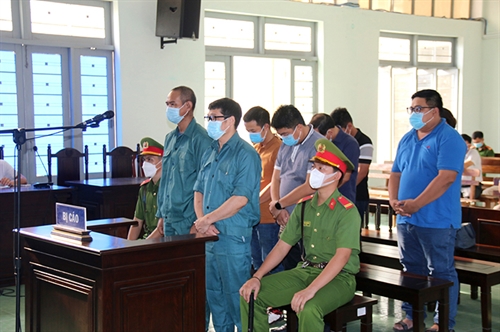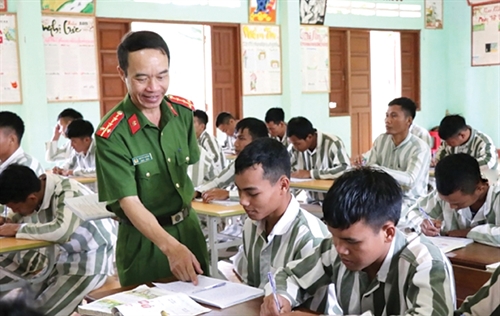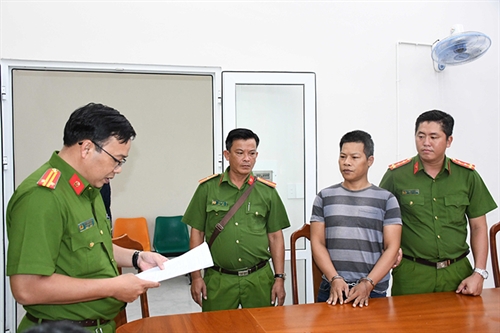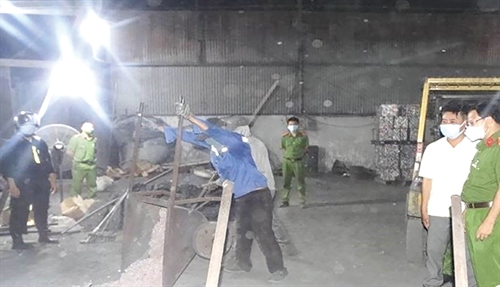After two decades of implementing the Judicial Reform Strategy under the Party’s resolutions, judicial reforms within people’s courts have recorded remarkable achievements, helping raise the position and prestige of courts. In order to successfully implement the Resolution of the 13th National Party Congress and the Resolution of the 6th plenum of the 13th Central Party Committee, it is a need to further renew the organizational apparatus and operation of people’s courts toward building the system of independent, professional, modern, equitable, civilized and incorruptible people’s courts serving the Fatherland and the people.
Assoc. Prof. Dr. Nguyen Hoa Binh[2]
Overview of the organizational apparatus of people’s courts
The organizational apparatus and operation of people’s courts at all levels have recently seen positive changes with their position and prestige heightened thanks to the effective implementation of guidelines, policies and orientations set out by the Party and the State. Prominent among these policies are the Politburo’s Resolution 08-NQ/TW of 2002 on a number of key tasks of judicial work and Resolution 49-NQ/TW of 2005 on the Judicial Reform Strategy through 2020. More notably, for the first time ever, the 2013 Constitution states: “People’s courts are the judicial bodies of the Socialist Republic of Vietnam and exercise judicial power.”[3] On that basis, the laws on the judicial system were enacted, contributing to improving the organizational apparatus of people’s courts, which are now organized into four levels. The way of holding a court hearing has been renovated through learning the rationalities of the model of adversarial procedures while courtrooms have been changed in their appearance. At the same time, the quantity and quality of judicial title holders within people’s courts have been raised while the jurisdiction of people’s courts at all levels has been specifically defined with more powers delegated to district-level people’s courts. The mechanism for people-elected bodies’ oversight of activities of people’s courts has been enhanced. Qualifications of personnel of people’s courts have become better[4]; the quality of adversarial procedures in trial has improved markedly; judicial administrative procedures at courts have been renewed, and judgments, rulings and other court activities have been made public.
However, the country’s judiciary is still facing challenges that prevent it from fully meeting the people’s needs and aspirations. Shortcomings have been seen in the organizational apparatus and competence of people’s courts at all levels, resulting in their low operational efficiency. Meanwhile, there remains a shortage of court staffs[5] while policies toward judicial title holders remain incommensurate to their task requirements. Judicial proceedings are inadequate, making trial activities less efficient[6]. Funds and physical foundations of people’s courts are insufficient to meet requirements of their task performance[7]; and international cooperation in judicial affairs remains limited[8]. The Party’s leadership mechanism for people’s courts and oversight activities of people-elected bodies still show some inadequacies.
 |
| Chief Justice of the Supreme People’s Court Nguyen Hoa Binh addresses at an online conference in Hanoi on March 31, 2022__Photo: Phuong Hoa/VNA |
Furthermore, violations, crimes and disputes become increasingly complicated with emergence of new ways of crime commission and new crimes, particularly information technology crimes and non-traditional crimes. Meanwhile, corruption crimes, though curbed, remain complex and have caused social anxiety.
Along with that, the judicial reform in Vietnam is facing a paradox between the work overload and the requirement for payroll downsizing. The substantive laws and judicial procedures are still set back with various shortcomings, thus failing to meet requirements of the settlement of disputes and the fight against crime, violations, corruption and waste as well as higher and higher requirements of the people and society on justice bodies and judicial staff. Therefore, people’s courts at all levels must truly be the people’s sanctuary for protection of justice, human rights and the socialist legislation and an effective tool to fight crimes of all kinds.
Major tasks of the judicial reform
Given the aforementioned limitations and shortcomings of the judicial system, in order to realize the goal of building and improving a socialist law-ruled state, the Resolution of the 6th plenum of the 13th National Party Congress has set out the key tasks of judicial reform, namely: (i) to improve policies and laws related to judicial work; and to define the jurisdiction of courts for them to fully and properly exercise the judicial power; (ii) to clearly differentiate between the tasks of first-instance trial, appellate trial and review of court judgments and rulings according to cassation procedures, and to build e-courts; and (iii) to formulate judicial procedure institutions centered on trial and regarding adversarial litigation as a breakthrough; and to ensure democratic, fair, civilized, modern, strict and accessible judicial proceedings, and improve efficiency of the people’s participation in court hearings.
The renewal of the organizational structure and operation of people’s courts at all levels is indispensable to better serve the Fatherland and the people. This is also a prerequisite for people’s courts to fulfill the missions of protecting justice, human rights and citizens’ rights, safeguarding the socialist regime, and protecting the interests of the State and the lawful and legitimate rights and interests of organizations and individuals. It is also the sacred responsibility of the courts stipulated in the 2013 Constitution, the laws on the judicial system and regulations on functions of bodies exercising the judicial power in the socialist law-governed state of Vietnam. Particularly, it is suggested to focus on several specific tasks. The first mission is to build Vietnam’s judicial system to be independent, professional, modern, just, strict, upright, effective and efficient. The second task is to ensure that courts have the full jurisdiction and capacity to handle violations, settle disputes arising in society and exercise the national jurisdiction. It is required to build up the court staff, first of all judges who must be clean, incorruptible, politically sound, professionally skilled, proficient in law, upright, courageous, disciplined and humane, while ensuring the specialization of judges and restructuring of judicial titles. Another duty is to renovate the organizational apparatus to be streamlined while facilitating proper performance of judicial functions and powers. It is also a must to improve the quality, operational efficiency and prestige of courts to help them truly personify justice. One more task is to step by step modernize physical facilities of courts and build e-courts.
Solutions to innovating the organizational apparatus of people’s courts
Renovating the organizational structure and operation of people’s courts at all levels aims to build judicial bodies truly for the people which serve the people, let the people enjoy justice through every judicial judgment or ruling, and protect the judicial authority. In the coming time, the restructuring of the organizational apparatus and renovation of operation of people’s courts at all levels should focus on the main solutions below.
Firstly, it is necessary to clearly define the connotation and characteristics of and subjects exercising the judicial power for use as a basis for formulating a clear assignment mechanism, ensuring close coordination and intensified control of the exercise of the state power to meet requirements of the building of a socialist law-ruled state of Vietnam. It is a need to clearly define the judicial power as courts’ adjudication, application of laws and making of judgments for cases, interpretation of laws, and judging of acts of state agencies and civil servants and the constitutionality and legality of laws and legal documents. In other words, the judicial power covers the right to adjudicate; the right to rule on matters relating to human rights and citizens’ rights; and the right to decide on the constitutionality and legality of legal documents[9].
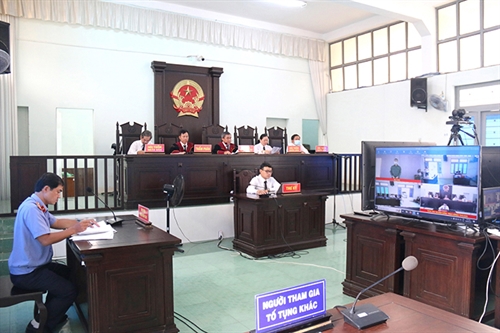 |
| The first-ever online court hearing of Binh Thuan province on September 6, 2022__Photo: Nguyen Thanh/VNA |
Secondly, it is proposed to improve regulations on competence and operation of people’s courts at all levels in order to fully and properly exercise the judicial power; clearly distinguish between the tasks of first-instance trial, appellate trial and cassation trial based on trial levels instead of administrative hierarchy; and clearly define the authority and procedures for settling human rights-related requests. The internal governance of people’s courts at all levels should also be renovated with the formation of full-time administrative bodies to perform tasks not directly related to the trial process. The National Judicial Council should be founded and tasked to formulate strategies and operation plans of people’s courts as well as regimes and policies for application thereof in judicial activities. It is suggested to establish trial-centered procedural institutions and more clearly define the competence and responsibilities of members of trial panels. The position and role of people’s courts should be clearly defined in relationships with other proceeding-conducting bodies. Adversarial litigation procedures, particularly regulations on evidence and proofs, rules and burden of proof, should be further improved with a view to ensuring more substantive litigations.
Thirdly, there should be solutions to improve the quality of human resources of people’s courts at all levels, making them more professionally qualified, courageous, humane, dedicated and fair, and to renew the structure of judicial titles, improve judge-related institutions in terms of rank structure and the assignment of judges at different levels of courts, and the mechanism for monitoring and handling the violating judges. Changes should be made in personnel selection and appointment with increased sources of personnel for judge appointment and intensified human resource training.
Other suggestions include ensuring the sufficient payroll with a structure of court staff suitable to their tasks and competence to conduct proceedings; formulating appropriate regimes and policies, particularly salary and remuneration ones, for judicial officials; and adopting an effective mechanism for protecting judges in order to maintain the judicial independence.
Fourthly, it is a need to consolidate physical foundations and ensure sufficient resources, focusing on improvement of legal institutions and ensuring proper understanding of the position and role of people’s courts, thereby adopting a mechanism for supplying sufficient resources for people’s courts to exercise the judicial power. Physical foundations of people’s courts at all levels should be modernized as commensurate to the status of judicial bodies. At the same time, a special financial mechanism should be implemented to reasonably allocate budgets for courts’ duty performance.
Fifthly, it is required to build e-courts to perform a number of court operations in the digital space so as to improve the operational capacity and efficiency of people’s courts, thus facilitating the people’s convenient and fast access to justice. E-courts should be built toward improving court governance capacity on digital platforms. Accordingly, e-courts will take part in providing public judicial services to the people and help judges improve their operational efficiency and quality and organize online proceedings. They are also expected to contribute to improving openness and transparency of court operations and maintaining connection with other digital platforms to share resources and support the process of building a digital society and digital economy and improving efficiency and effectiveness of the national administration.
Sixthly, international cooperation of people’s courts should be intensified, focusing on consolidating the legal system on international cooperation and stepping up the negotiation and conclusion of bilateral and multilateral international agreements on judicial maters, first of all with neighboring countries, regional countries, countries with traditional relations with Vietnam, and countries with developed judiciary. It is advised to build a contingent of capable judicial staffs who are specialized in international law, particularly judges and key leaders of people’s courts at all levels and officers directly engaged in court proceedings-related international cooperation activities who satisfy international integration requirements. People’s courts are also recommended to enhance exchange of experience in international judicial matters for heightening their role and position in international institutions of which Vietnam is a member state. In addition, it is necessary to promote international cooperation in settling and adjudicating civil matters and criminal and administrative cases involving foreign elements.
Last but not least, the Party’s leadership over the system of people’s courts at all levels is a particularly important factor to ensure the success of the judicial reform. The Party leads the court but still adheres to the principle of judicial independence, and does not interfere in court proceedings to resolve specific cases so as not to affect justice. Therefore, it is necessary to develop a model of Party organizations and arrange personnel to participate in executive boards of Party Committees. Specifically, the Party Committee of the Supreme People’s Court consists of Party organizations of the Supreme People’s Court, superior people’s courts and first-instance tribunals. The Party Caucus Committee of the Supreme People’s Court submits to the direct leadership by the Politburo and the Secretariat.
At local levels, the Party Committee of a people’s court of appeal will be established under the provincial-level Party Committee, which is composed of Party organizations of the people’s court of appeal and regional people’s courts of first instance.
By hierarchy, the chief justice of a people’s court at a certain level will be assigned to participate in the executive board of the same-level Party Committee with a position higher than his current position as suitable to each locality. Accordingly, the Chief Justice of the Supreme People’s Court will be a Politburo member and concurrently a Secretariat member. Chief justices of people’s courts of appeal in provinces and centrally run cities and populated provinces serving as socio-economic development and cultural centers of the country will be members of standing boards of provincial-level Party Committees; and chief justices of people’s courts of appeal of the remaining provinces will be members of executive boards of provincial-level Party Committees. Particularly, chief justices of superior people’s courts and chief justices of first-instance tribunals will be members of the Executive Board of the Party Committee of the Supreme People’s Court; and chief justices of regional people’s courts of first instance will be members of executive boards of Party Committees of people’s courts of appeal.-
[1] The Vietnamese version of this article was published in January 2023 issue of Tap chi Cong san (Communist Review).[2] Member of the Party Central Committee’s Political Bureau, member of the Party Central Committee’s Secretariat, Chief Justice of the Supreme People’s Court.[3] Article 102.3 of the 2013 Constitution.[4] So far, personnel of people’s courts at all levels include three professors and associate professors, 47 doctors, 2,205 masters and nearly 11,000 bachelors. The other staff members possess qualifications relevant to their titles and working positions. Of these personnel, some 2,340 persons possess bachelor or advanced degree and nearly 4,200 persons hold intermediate degree in political theory.[5] The payroll was approved by the National Assembly Standing Committee in 2012, based on the number of cases and matters settled by people’s courts at all levels which is nearly 304,000 per year. This number is almost doubled now and expected to increase in the coming years while the payroll is even lower than the 2012’s figures as a result of the implementation of the policy on downsizing payroll and restructuring personnel.[6] For instance, there exist regulations on rights and responsibilities of courts to collect evidence in administrative proceedings; but there are no sanctions to be imposed on those failing to provide documents and evidence; there are no specific regulations on e-proceedings aiming to increase the people’s access to justice; due attention has not been paid to the feasibility and economization in proceedings, leading to low efficiency of judgment execution.[7] The mechanism for allocation of budget funds for court operation is subject to the Government’s decision, limiting the courts’ autonomy in managing and using budgets and leading to incomplete understanding of the role and independence of courts in their relationships with other state agencies.[8] The number of treaties in the field of mutual legal assistance in criminal and civil matters is modest while judges and court staff have little experience in foreign law and poor foreign-language proficiency.[9] See Article 3 of the United States Constitution; visit https://www.judiciary.uk/about-the-judiciary/our-justice-system.jud-acc-ind/judges-and-parliament/ for more information.




